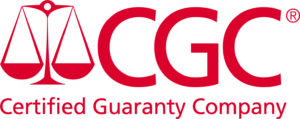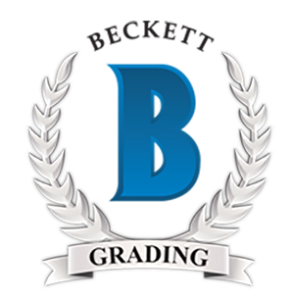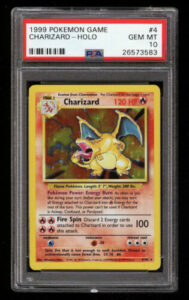“Should I get it graded?” The WotC Era
A good chunk of questions I see on the Pokemon TCG social media groups are to do with Grading. ‘Should I grade this?’ ‘Where do you grade?’ ‘How long does it take?’ etc. Funnily enough, we get those same questions through the store a lot as well. People dig up their old childhood collections buried beneath the boxes of Christmas decorations in the loft, they go online to see what the cards are worth and usually either look to sell them or complete their sets and indulge in some childhood nostalgia. Naturally we get a lot of calls looking for advice, and because grading has now become so widespread a lot of people ask if they need to be graded to sell them.
The answer is, of course, no they don’t. The vast majority of Wizards of the Coast era cards that pass through the store, especially the most common sets of Base to Team Rocket, have received some classic childhood love. Edgewear, creases, holo scratches and the like are all fairly common, and thus most of the cards aren’t what we would consider gradable, but they’re still worth something. Take the classic Charizard 4/102 unlimited edition from Base set, perhaps the most iconic Pokemon card in the world. ‘Zard fetches the highest raw (ungraded) price out of any holographic card in Base to Team Rocket. The average copy we see is worth around £150, and is usually the equivalent to a PSA 5 or 6. As of April 2022, the price of grading through PSA is $50 for the Economy service, with a 4 month turnaround. A PSA 6 is worth £200, so at the current cheapest service you would effectively be breaking even if you sent your Charizard at that price. However, a PSA 7 can add another £100 to the price quite easily. Because Charizard is so popular, it shouldn’t be difficult to quickly flip it online and save yourself the hassle if you want the money quickly, but how do you tell if it’s worth waiting that extra time to get it graded? Everyone’s personal idea of the condition varies. Any idea how many calls we get where people say they’ve got a near mint 1st edition Charizard, only for them to come in and present us an unlimited version peeling at the corners? It’s still worth something, but certainly not as much as they might have hoped and nor is it really worth grading.
So PSA is currently $50 a card, which makes it very difficult to send anything that isn’t Charizard, Blastoise, or Venusaur (or some of the other popular Pokemon from later sets like Gengar and Dragonite) and make money off it, so what are the alternatives? Well, for the purpose of making the biggest buck there really isn’t a good option. Other recognised companies like Beckett and CGC that have been grading for years are also fairly expensive for a lot of low-end cards these days, as well as having a similar turnaround time. A lot of new grading companies popped up during the Pandemic in the UK (and more still are to this day) to offer services at a much cheaper and faster rate, but then the next question is are they trustworthy and do they add value to your card? Without getting into great detail, for now the latter answer is no. PSA has been grading for over 30 years, it is not difficult to see why people place so much faith in their grading services compared to much younger companies, some of which are less than a year old. This isn’t to say grading with a newer company isn’t worth your time, you just have to be prepared to wait much longer on your investment instead of getting it back in a slab and immediately sticking it on ebay for a premium. Sometimes it works, often you end up getting the raw price + grading fees.
If you’re intending to keep the card to display or just hold onto, The Brotherhood always recommends finding a company whose slabs you like, but also making sure to keep informed about their grading quality and methods. The fact is that every company is different. Many do subgrades and break the final grade down into four categories (Surfaces, Centering, Edges, and Corners), but some do an average for the final grade, while others won’t give you a final grade more than .5 of a score above your lowest subgrade (for example a 10 in surfaces, corners, and edges can still only get a 9 if the centering is an 8.5).
Obviously this can all be very overwhelming whether you’re a long-time collector looking to start grading or just someone who discovered their old collection in the loft. So my next recommendation is to always bring the cards in person to a reliable source to get pregraded if possible. Don’t post pictures online, because everyone and their uncle thinks their naked eye is an electron microscope and you simply can’t see all the possible imperfections from an iPhone camera. A UV light and a magnifying glass is honestly the bare minimum you should be using for WotC cards. Then if you do notice imperfections it’s tough to figure out how that will affect the final grade. PSA has a helpful guide for their grading standards on their website here, and you can very easily see the first quality differences between a 10 grade and a 4 without even looking closer. They even tell you how much leeway there is on centering between an 8 and a 9, for example. You’ll quickly notice they prioritise the front of the card over the back, which means even a slight imperfection on the back can still be graded a 10, a fact I’ve noticed from some of my own graded cards where I might have cautiously expected a 9.
However, with all of the above in mind, you can see there is value even as a PSA 6 from some of the higher end cards, so your cards don’t have to be all 9s and 10s to be worth grading, and that brings us to the most important point. Every card has its own value and not everything is worth grading. A PSA 10 uncommon Magikarp from Base Set is worth $60~, which means even if your copy is pristine it’s still not really worth grading at the current price; the same goes for the majority of the non holos. You still need to do your research into the raw price compared to the graded price. For another example, a PSA 6-8 Chansey 3/102 also from Base set ranges from $20-$50 just based on some sold data from April. This card was just as hard to pull as Charizard back in the day, but you would actually lose money by sending it off as opposed to just selling the raw copy. Why are the prices like this? Because now we come full circle, with the average copy being rediscovered in the loft 20+ years later in that PSA 6 quality, whereas the PSA 9s and 10s are incredibly scarce because not only was Pokemon not as popular back then, but also how many kids kept their stuff sleeved and toploadered straight from the booster pack? I certainly didn’t, but I enjoyed them all the same.
Modern Pokemon is a whole different story, and as I gaze over my Chilling Reign full arts with alignment dots up the wazoo, it’s a story for another day…




